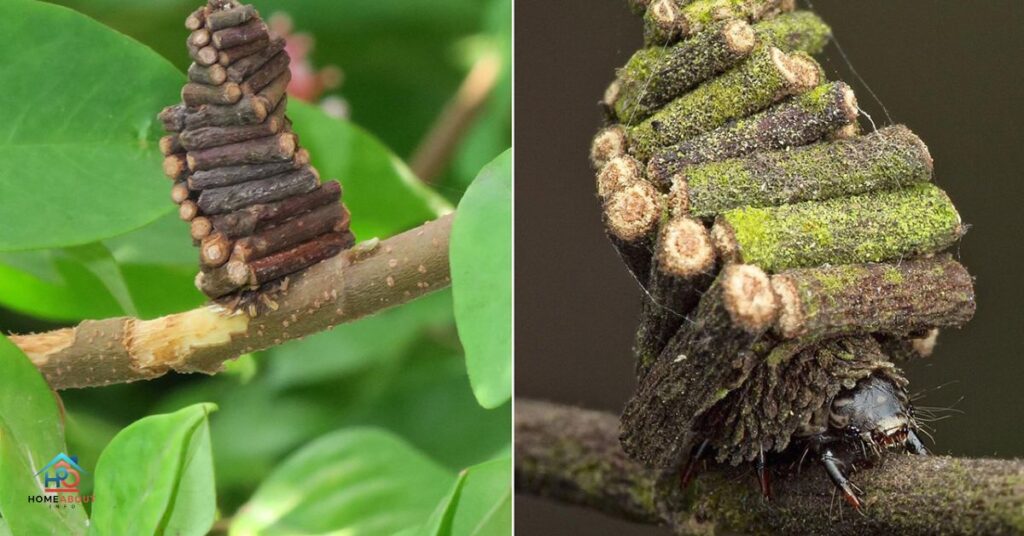If you find bagworms in your house. There are simple ways to get rid of them. Bagworms are small pests that can cause damage to your plants and trees. By taking quick action you can eliminate them from your home.
First identify the signs of a bagworm infestation. Look for cone like bags hanging from branches or dead branches on your plants. Once you have confirmed the presence of bagworms. you can start and removing them.
Handpicking bagworms off your plants is an effective method. Simply wear gloves pick them off and drown them in soapy water. you can use insecticides or natural remedies to treat the infestation. With these steps you can keep your house free from bagworms and protect your plants.
What Are Plaster Bagworms?
Plaster bagworms are small insects that make cocoons on walls or ceilings. They are also known as household casebearers. These pests construct protective cases from silk and debris like dust and lint. They can be a big annoyance to homeowners.

Bagworm larvae stay inside these cases, sticking them to various surfaces. They are not directly harmful to humans but they can cause damage to plaster walls. Plaster bagworms are common in homes especially in humid climates like Singapore.
To get rid of plaster bagworms, regular cleaning and vacuuming are essential. Removing existing cases by hand and maintaining proper lighting can also help deter them. Consulting pest professionals may be necessary for severe infestations.
Read this blog : HOW DID RANDY DIE ON HOME IMPROVEMENT SEASON 1?
Signs of Bagworms
Signs of bagworms are easy to spot. Look for missing leaves or needles. Dead branches might signal their presence too. If you notice brown spots on your plants check for bagworms. Also keep an eye out for cone-like bags hanging from branches.
Sometimes, other pests cause similar problems. Gypsy moths can defoliate trees. Snailcase bagworms might be on conifers. Birds like sparrows can damage plants but rarely cause brown spots on foliage.
If you see these signs, act fast. Handpick bagworms if you catch them early. Use environmental changes to deter them. Applying insecticides or natural remedies can help too.
How To Get Rid Of Plaster Bagworms

To get rid of plaster bagworms start by cleaning your home regularly. Vacuum corners, walls. and ceilings to remove dust and debris which the bagworms use to build their cocoons.
Carefully remove existing bagworm cocoons by hand or with a soft brush. Be gentle to avoid damaging surfaces and dispose of the cocoons in sealed plastic bags to prevent infestation.
Using insecticides designed for bagworm control as a last resort. Follow the instructions carefully and take safety precautions. If the infestation is severe, consult pest control professionals for assistance.
Regular Cleaning And Vacuuming
Here are some points related to regular cleaning and vaccuming.
- Regular cleaning and vacuuming help remove dust, lint, and debris.
- Plaster bagworms use these materials to construct their protective cases.
- By eliminating their food sources, you can discourage bagworm infestations.
- Pay special attention to corners, walls, and ceilings during cleaning sessions.
- Consistent cleaning routines are crucial for keeping homes free from plaster bagworms.
Remove Existing Cases
To remove existing cases gently peel them off your walls or ceilings by hand. Be careful not to damage the surfaces while doing so. Dispose of the removed cases in a sealed plastic bag to prevent re-infestation.
Cleaning the area thoroughly afterward is essential to remove any remaining debris. Regularly inspect your home to catch any new cases early and remove them promptly to prevent further infestation.
Maintain Proper Lighting
Maintaining proper lighting is essential for a cozy and inviting home atmosphere. Bright lights can make spaces feel more spacious and cheerful. Dim lighting especially in corners and alcoves.
We can create a cozy ambiance perfect for relaxation or intimate gatherings. Using LED lights with warm tones can help save energy and create a welcoming glow throughout your home.
Read this blog Also : HOW TO INSTALL VINYL PLANK FLOORING IN BATHROOM
Seal Cracks And Openings

Sealing cracks and openings is important. It stops bagworms from entering your home. Look for gaps in walls and ceilings. Caulk or seal them tightly. This keeps bagworms out.
Inspect your home carefully. Find any tiny openings. Use appropriate materials to seal them. This prevents bagworms from getting inside. Protect your home from these pests.
Reduce Humidity
Reducing humidity is important. High humidity can cause problems. It can lead to mold growth. Mold can damage your home. To reduce humidity, try these tips. Use a dehumidifier in your home.
Fix any leaks in pipes or faucets. Ventilate your bathroom and kitchen well.By reducing humidity, you can prevent problems. Your home will be healthier. You’ll breathe easier too.
Natural Predators
Some natural predators are here.
Trichogramma Wasps: Parasitic wasps that lay eggs inside bagworm eggs, preventing infestations.
Birds: Some bird species such as sparrows, feed on bagworms, helping control their population.
Insects: Certain insects like lacewings and ladybugs, prey on bagworm eggs and larvae.
Spiders: Some spider species consume bagworms, reducing their numbers in the environment.
Bats: Bats may feed on adult bagworm moths, contributing to natural pest control efforts.
Insecticides

Insecticides kill bugs. They come in sprays. Sprays are easy to use. Just spray on plants. Follow the instructions carefully. Don’t use it too much. Some insecticides are harmful. Harmful ones can hurt plants.
Be careful when using them. Always read labels first. Choose safe options if possible. Insecticides help plants stay healthy. They stop bugs from eating them. Use them when needed. But always handle it with care.
Consult Pest Professionals
When bagworms overrun your trees seek help. Pest professionals know what to do. They have the expertise you need. With their knowledge they will tackle the infestation. They will use safe methods to protect your plants. Trust them to restore your greenery. Don’t hesitate to consult pest professionals.
Frequently Asked Questions
Why should I consult pest professionals?
Pest professionals have the expertise to effectively deal with pest infestations.
Are pest professionals equipped to handle various pest issues?
Yes, they are trained to address a wide range of pest problems.
Will pest professionals provide personalized solutions?
They offer tailored advice based on your specific pest situation.
Are the methods used by pest professionals safe?
Yes they employ safe and approved methods to eliminate pests.
Can pest professionals help minimize risks to health and the environment?
Yes they take measures to ensure minimal impact on human health and the environment.
Conclusion
Dealing with bagworms in trees and shrubs requires a multi-faceted approach. By handpicking the bags, changing the environment to deter pests, using insecticides, and introducing natural predators, you can effectively manage infestations.
Organic remedies like neem oil and spinose along with planting moth repelling plants and adjusting outdoor lighting. And offer eco-friendly solutions to keep bagworm populations in check. With consistent effort and a combination of these methods, you can protect your plants from the damaging effects of bagworm infestations and maintain a healthy garden environment.

Ava, boasting five years in home blogging, shares expertise in domestic living. With a sharp eye and passion for details, she navigates home decor and lifestyle intricacies effortlessly.







